
St. Augustine is a city in and the county seat of St. Johns County on the Atlantic coast of northeastern Florida. Founded in 1565 by Spanish explorers, it is the oldest continuously inhabited European-established settlement in what is now the contiguous United States.
David Nolan is an American author, civil rights activist, and historian.

The Casa Monica Hotel is a historic hotel located in St. Augustine, Florida, in the United States. It was originally named Casa Monica, then Cordova Hotel, then Alcazar Annex, and now has its original name again. The Casa Monica Hotel is one of the oldest hotels in the United States and is a member of the Historic Hotels of America in the National Trust for Historic Preservation.

The St. Augustine Light Station is a privately maintained aid to navigation and an active, working lighthouse in St. Augustine, Florida. The current lighthouse stands at the north end of Anastasia Island and was built between 1871 and 1874. The tower is the second lighthouse tower in St. Augustine, the first being lit officially by the American territorial government in May 1824 as Florida's first lighthouse. However, both the Spanish and the British governments operated a major aid to navigation here including a series of wooden watch towers and beacons dating from 1565.

Ximenez-Fatio House Museum is one of the best-preserved and most authentic Second Spanish Period (1783-1821) residential buildings in St. Augustine, Florida. In 1973, it was added to the National Register of Historic Places. It was designated a Florida Heritage Landmark in 2012.
Michael Alexander Arbuthnot is an archaeologist, instructor and archaeological filmmaker.

The St. Augustine movement was a part of the wider Civil Rights Movement, taking place in St. Augustine, Florida from 1963 to 1964. It was a major event in the city's long history and had a role in the passage of the Civil Rights Act of 1964.
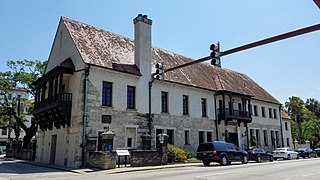
Government House, also known as Governor's House, is located at 48 King Street in St. Augustine, Florida, adjacent to the Plaza de la Constitución. The building, constructed of coquina, served as the governor's official residence from c. 1710 during the First Spanish Period (1565–1763), throughout the British Period (1763–1784), and until 1812 in the Second Spanish Period (1784–1821). Governor Gonzalo Méndez de Canzo was the first governor to build his residence on the present Government House site in 1598.
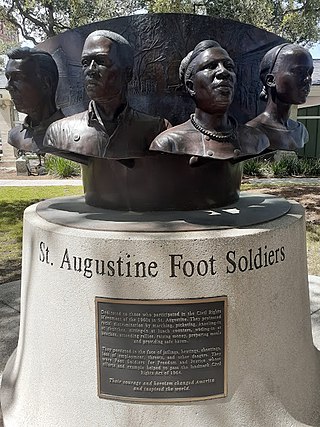
St. Augustine Foot Soldiers Monument is located near the corner of King St. and Charlotte St. in the Southeast corner of the Plaza de la Constitución, a historic public park in downtown St. Augustine, Florida. It is in remembrance of the people who engaged in various forms of peaceful protest in St. Augustine in the early 1960s to advance the cause of civil rights, contributing to the passage of the Civil Rights Act of 1964. The monument, commissioned by the St. Augustine Foot Soldiers Remembrance Project, Inc., was installed and unveiled in May, 2011.
Audrey Nell Edwards is an African-American civil rights activist, best known for her participation in the St. Augustine movement in 1963.
Robert Bagner Hayling was an American dentist and civil rights activist.

The Monson Motor Lodge, at 32 Avenida Menendez, Saint Augustine, Florida, was in 1964 the site of a landmark protest event of the Civil Rights Movement. The site was before that occupied by the Monson House, a 19th-century boarding house.
Kathleen A. Deagan is an American archaeologist who primarily focuses on excavations in Florida and the Caribbean. Known for her historic archaeology which uncovered the colonial past of La Florida, and work in St. Augustine, she has received multiple awards and honors, including the Award of Merit in 1992 and the J. C. Harrington Award in 2004, both bestowed by the Society for Historical Archaeology.
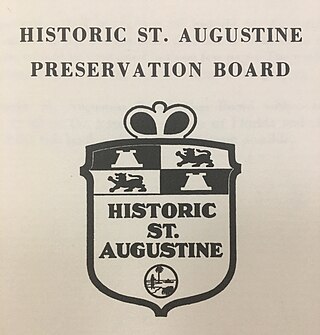
The Historic St. Augustine Preservation Board (HSAPB) was a state agency in Florida that participated in the restoration and preservation of historic buildings in St. Augustine, Florida from 1959 to 1997. Created in 1959 by Governor LeRoy Collins, the agency acquired, restored, and preserved historic structures in St. Augustine until its abolishment by the State of Florida in June 1997.
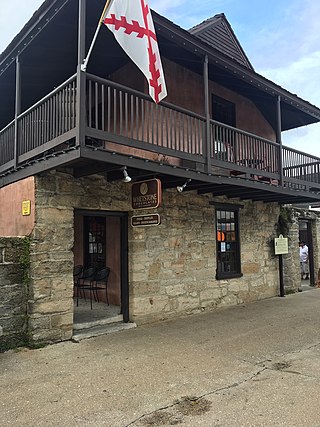
The Salcedo House and Kitchen are located at 42 and 42 1/2 St. George Street, in St. Augustine, Florida. They are reconstructions of 18th century structures that stood on these sites in St. Augustine's First Spanish Period (1565–1763).
Herbert E. Wolfe (1897-1981) was an American businessman, banker, philanthropist, farmer, and mayor of St. Augustine, Florida.

The Cubo Line was part of the defense system built by the Spanish to protect the presidio of St. Augustine in the territory of Spanish Florida during the early years of the 18th century.
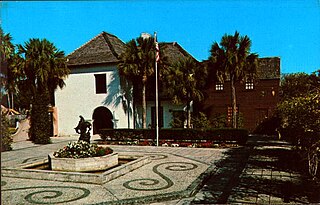
The Hispanic Garden is a garden in St. Augustine, Florida.
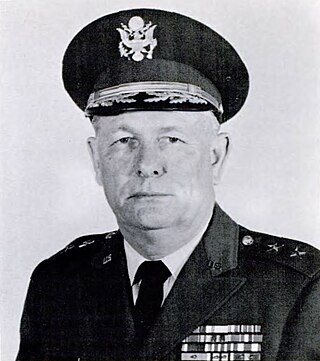
Major General Henry W. McMillan was an Adjutant General of Florida (1962-1975) and a longstanding service member in the Florida National Guard and the United States Army.
John D. Bailey was a civic leader and philanthropist in, and Mayor of, St. Augustine, Florida from 1965 to 1967.












